
The Role of Relationship Management in Systemic Conversation Management
Benefits of Relationship Management in Systemic Conversation Management
Challenges in Implementing Relationship Management in Systemic Conversation Management
Strategies for Effective Relationship Management in Systemic Conversation Management
Systemic conversation and relationship management are two interconnected concepts that are gaining traction in the business world. Systemic conversation management is managing conversations and relationships between people in an organization. The goal is to create a positive, productive, and collaborative environment for employees to communicate and build relationships. In addition, systemic conversation and relationship management is a methodology that seeks to create an atmosphere of trust and respect, allowing for better communication and collaboration.
The Role of Relationship Management in Systemic Conversation Management
Relationship management plays an integral role in systemic conversation management. First, it is managing relationships between people in an organization to foster collaboration and trust. This can include developing and strengthening employee relationships, understanding and addressing conflicts, and finding ways to build bridges between stakeholders. Relationship management also involves:
Developing relationships between departments.
Identifying opportunities for collaboration and problem-solving.
Promoting understanding between different perspectives.
Benefits of Relationship Management in Systemic Conversation Management
Developing relationships and building trust between employees, departments, and stakeholders have several benefits for systemic conversation management. By creating a positive and collaborative environment, conversations and conversations are more likely to be effective and productive. As employees feel more comfortable expressing their ideas and opinions, discussions are more likely to be productive and collaborative. Also, relationship management can help build bridges between stakeholders, allowing for better communication and collaboration.
Challenges in Implementing Relationship Management in Systemic Conversation Management
Although relationship management can positively affect systemic conversation management, some challenges must be addressed. Relationship management requires time and effort and can be difficult to implement in a large organization. It can also be challenging to foster relationships between stakeholders and departments, as they may have different cultures and perspectives. Finally, ensuring that relationship management is effective and positively affects systemic conversation management can be difficult.
Strategies for Effective Relationship Management in Systemic Conversation Management
Several strategies can be used to ensure that relationship management is effective and positively affects systemic conversation management:
Organizations should prioritize the development of relationships between employees, departments, and stakeholders. This can include creating opportunities for collaboration, understanding different perspectives, and providing training and resources to help employees build relationships.
Organizations should use tools like surveys, feedback loops, and data analysis to measure relationship management's effectiveness and identify improvement areas.
Organizations should ensure that all employees know the importance of relationship management and its role in systemic conversation management.
Conclusion: Systemic conversation and relationship management are two interconnected concepts gaining traction in business. Relationship management plays an integral role in systemic conversation management, as it seeks to create a positive, collaborative, and productive environment for conversations and conversations. Developing relationships and building trust between employees, departments, and stakeholders can benefit systemic conversation management. However, some challenges must be addressed. Organizations should use a variety of strategies to ensure that relationship management is effective and has a positive effect on systemic conversation management.
The quality of conversations determines the quality of relationships.

Frequently Asked Questions
What is Systemic Conversation & Relationship Management?
Systemic Conversation & Relationship Management (SCRM) is an emerging field of study that uses technology and data-driven tools to manage conversations, relationships, and customer experiences. It is an essential component of customer experience management that enables companies to improve customer interactions.
At its core, SCRM is about understanding how conversations between customers and companies can be improved through technology. By leveraging data-driven insights, companies can better understand their customer's preferences and needs, enabling them to craft more effective conversations. This data-driven approach allows companies to identify areas where there may be room for improvement in their customer service process or conversation strategy. Additionally, it enables them to track customer feedback over time, allowing them to better understand how their customers feel about their products or services.
In addition to improving the customer experience, SCRM helps companies build lasting relationships by providing personalized communication tailored to each customer's needs. By using analytics tools such as Natural Language Processing (NLP) and Machine Learning (ML), companies can gain insights into the types of conversations that are most successful with each customer. This helps them tailor content specifically for that person to provide a more personalized experience while also helping them build a stronger relationship with them over time.
SCRM has become increasingly popular due to its ability to improve the quality of conversations between businesses and customers while allowing for more efficient use of resources. Additionally, it has been used by many organizations to create more meaningful relationships with their customers, which can ultimately lead to increased loyalty and sales down the line. As such, it is essential for any business looking to provide superior customer service and relationship management solutions in today's digital world.

What is the role of Relationship Management in Systemic Conversation Management?
Relationship management is an essential factor in the process of systemic conversation management. Systemic conversation management is a process of managing conversations systemically. It involves using various tools and techniques to facilitate discussions, including developing relationships, managing expectations, and managing conversations.
The role of relationship management in systemic conversation management is to create and maintain relationships between the stakeholders involved in the conversation. This includes the parties involved in the discussion, the facilitator, and the organization. Relationship management is essential to systemic conversation management because it helps ensure that conversations are productive and that all stakeholders can contribute effectively. It also helps create an environment where all stakeholders feel comfortable and respected.
Relationship management involves establishing a shared understanding of the conversation's context and the stakeholders' expectations. It also involves creating a space for dialogue where stakeholders can share ideas and perspectives. Furthermore, relationship management creates a safe and supportive conversation environment where everyone can feel heard and respected.
To effectively manage conversations, creating a trusting relationship with all the stakeholders is essential. This requires establishing common goals, communicating openly and respectfully, and building relationships. The facilitator must also be aware of the dynamics of the conversation and be able to change the tone and direction as needed.
In addition, relationship management can help to ensure that conversations remain on track. This includes setting clear objectives, managing expectations, and providing feedback. Ensuring that all stakeholders actively participate in the discussion is also essential.
Finally, relationship management is essential for systemic conversation management because it helps to ensure that conversations remain respectful and productive. It is important to remember that all exchange is fluid and that the facilitator must be able to adjust the tone and direction of the conversation as needed. Fostering relationships between all stakeholders and ensuring everyone can contribute effectively is essential to successfully managing conversations.
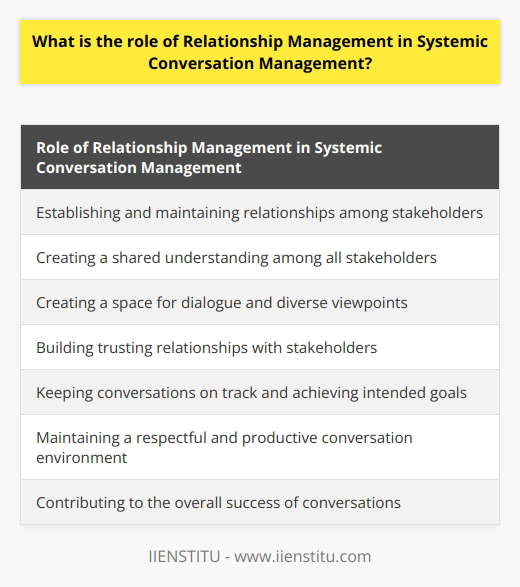
What are the benefits of Relationship Management in Systemic Conversation Management?
Relationship management has become increasingly important in the modern business environment, becoming an essential tool for systemic conversation management. This article will explore the benefits of relationship management in the context of systemic conversation management.
First, relationship management can help build trust between parties in a systemic conversation. By developing relationships among different stakeholders, all parties can better understand each other's needs and perspectives. This understanding can lead to more effective communication, as well as more effective decision-making. Additionally, by fostering stakeholder relationships, conversations can be conducted with mutual respect and understanding.
Second, relationship management can help create a framework for successful conversations. They are developing relationships among stakeholders before exchanges can establish expectations for the discussion ahead of time. This helps ensure that all parties are on the same page before the conversation begins and that everyone involved is aware of what is expected from them during the conversation. Additionally, it reduces misunderstandings arising from random questions or topics being discussed during a conversation.
Third, relationship management allows greater stakeholder collaboration in a systemic conversation environment. Cultivating relationships among stakeholders before a discussion makes collaboration easier since all parties feel comfortable discussing their opinions and ideas without fear of being judged or criticized unfairly by others involved. Additionally, by having established relationships before engaging in a systematic conversation, participants are better able to work together towards achieving common goals and objectives since they already have some level of trust built up with each other beforehand, which allows them to focus on problem-solving instead of worrying about potential conflicts that could arise due to lack of familiarity with each other's positions or agendas.
Finally, relationship management facilitates better decision-making within systemic conversations and greater engagement from all parties involved due to increased trust, which leads to high-quality dialogue and discussion about important topics related to the overall goal or objective being discussed. As such meetings progress further along towards resolution or agreement on particular issues raised by those participating in the discussion, then more accurate decisions based on facts rather than assumptions are likely due to all parties having access to previously facts from previous interactions, which can then be used as reference points during any given situation encountered throughout these discussions.
In conclusion, many benefits are associated with utilizing relationship management within systemic conversations, such as increased trust among stakeholders and higher quality dialogue while facilitating smoother collaboration between participants, resulting in improved decision-making capabilities overall. Thus, it is essential for any organization looking to maximize its effectiveness through efficient communication amongst its members to utilize this powerful tool when engaging in systemic conversations, whether internally amongst employees or externally amongst customers.

What are the key components of effective conversational management in interpersonal communication?
Key Components of Effective Conversational Management
Establishing a Solid Foundation
In interpersonal communication, the first essential component of effective conversational management is setting up a solid foundation. This involves understanding the purpose of the conversation and ensuring that all parties involved are comfortable and respected.
Active Listening
One crucial aspect of conversational management is active listening. This skill enables individuals to fully comprehend the message that their conversation partner is attempting to convey. By attentively focusing on the speaker, asking clarifying questions, and summarizing shared information, active listeners can foster open and constructive conversations.
Turn-taking
Another important component of conversational management is the practice of turn-taking. This orderly exchange of speaking and listening roles allows each participant to express their ideas and opinions effectively. Mutual respect for individuals' speaking rights and observing appropriate pauses can contribute to the smooth flow of conversation.
Building Rapport
In order to manage conversations effectively, it is essential to build rapport with the other party. This can be achieved by expressing empathy and understanding the other person's perspective. Using suitable body language, maintaining eye contact, and engaging in small talk help in building trust and promoting openness.
Appropriate use of Language
Employing appropriate language is key in effective conversation management. Exhibiting clarity, brevity, and cultural sensitivity ensures that information is accurately transmitted and well-received. Avoiding jargon, choosing words wisely, and adapting communication style to suit the listener are vital skills to foster constructive conversations.
Feedback Mechanism
Finally, an essential component of conversational management is the feedback mechanism. By providing constructive feedback and requesting clarification when needed, individuals can ensure that both parties are on the same page. Feedback allows for adjustments in the communication process, contributing to the overall effectiveness of the conversation.
In conclusion, effective conversational management is a multifaceted process involving various components. Focused attention, active listening, turn-taking, building rapport, employing appropriate language, and utilizing feedback mechanisms contribute to successful interpersonal communication. By mastering these essential skills, individuals can engage in fruitful and meaningful conversations across various contexts.
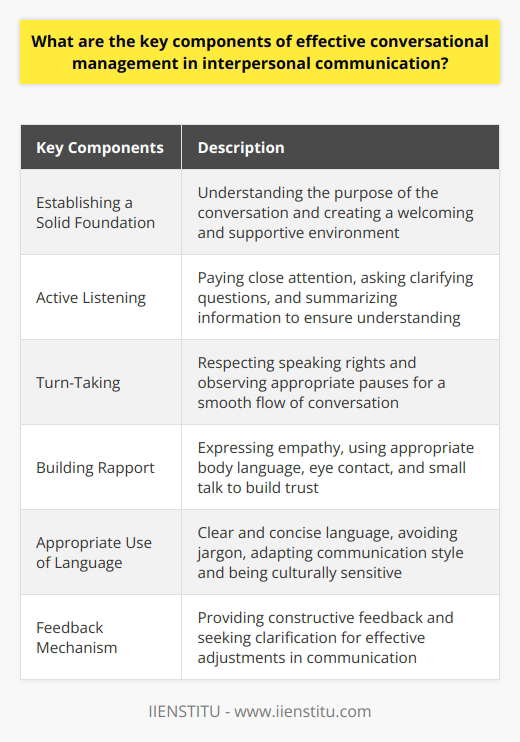
How does conversational management influence the dynamics between individuals during interpersonal interactions?
Role of Conversational Management
Conversational management shapes the dynamics between individuals during interpersonal interactions through various factors. These include initiating discourse, sustaining the conversation, and guiding the direction of the discussion.
Initiating Discourse
The initial establishment of a dialogue plays a crucial role in setting the tone for subsequent interaction. By choosing an appropriate topic or open-ended question, individuals shape the nature of the conversation and lay the foundation for mutual engagement. This management skill allows participants to explore common ground and foster rapport, which in turn positively impacts the interpersonal dynamics.
Sustaining the Conversation
Effective conversational management includes maintaining the flow of dialogue and ensuring that it remains engaging for all participants. Employing active listening and displaying interest in others' perspectives help to sustain a conversation. By asking follow-up questions and validating the other party's input, an environment of mutual respect and open communication can be achieved. This environment contributes to a positive exchange and directly influences the dynamics between individuals.
Guiding the Direction
Another aspect of conversational management involves the ability to guide the direction of the discussion. This often includes steering the conversation away from contentious topics or skillfully navigating through potential conflicts. Successfully managing the direction of a conversation allows for a smoother interaction and promotes positive outcomes, directly influencing the interpersonal dynamics between people.
Adapting to Individual Differences
Conversational management also requires adapting communication styles to suit the needs and preferences of different individuals. Acknowledging and considering the differences in verbal cues, cultural backgrounds, and personal experiences can lead to a more conducive environment for successful interactions. By being adaptable and sensitive to different contexts, conversational managers can set the stage for positive experiences and outcomes.
In conclusion, conversational management impacts the dynamics between individuals by determining the tone, flow, and direction of interpersonal interactions. It entails initiating discourse, maintaining engagement, guiding the discussion, and being adaptable to individual differences. By mastering these skills, individuals can enhance their communication and navigate interpersonal interactions with greater ease and effectiveness.
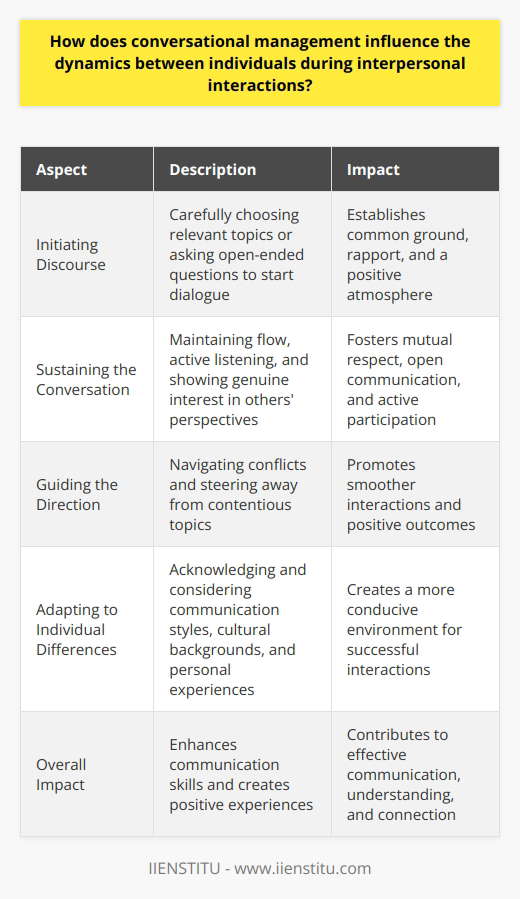
In what ways can individuals enhance their conversational management skills for improved communication and relationship building?
Introduction to Conversational Management Skills
Conversational management skills play a crucial role in facilitating effective communication and fostering strong relationships. To improve these skills, individuals can focus on several key aspects, as discussed below.
Active Listening
One of the core components of successful communication is active listening. Individuals should focus on genuinely understanding the speaker's message by paying attention to verbal and nonverbal cues. Asking relevant questions and acknowledging the speaker's emotions can enhance empathic understanding and open up opportunities for deeper conversations.
Effective Use of Questions
Asking appropriate questions can guide conversations in meaningful directions. Open-ended questions allow speakers to express themselves freely, while close-ended questions can be used to gather specific information. By employing the right balance of question types, individuals can develop richer conversations and strengthen interpersonal connections.
Nonverbal Communication
Nonverbal cues such as eye contact, facial expressions, and body language have a significant impact on communication. Cultivating greater awareness of nonverbal cues enhances conversational management skills, as it allows individuals to gauge the emotional state of others and adjust their approach accordingly. People can also use their body language to convey empathy, interest, and appreciation, reinforcing positive interactions.
Building a Common Ground
Effective communicators can facilitate connection and rapport by identifying shared interests, values, or experiences. Tapping into common ground helps create a sense of belonging and establishes a solid foundation for further conversation. This approach can lead to stronger, more lasting relationships and improved communication.
Politeness and Respect
Maintaining a respectful and polite attitude during conversations can foster better communication and relationship building. By using culturally appropriate greetings, expressions, and manners, individuals can create a positive atmosphere that encourages open dialogues and minimizes misunderstandings.
Assertiveness and Self-Awareness
Being assertive and self-aware in communication can improve conversations by making it easier for others to understand one's message. Assertiveness involves expressing ideas and feelings respectfully, without aggression or passivity. Meanwhile, self-awareness allows people to gauge the impact of their words on others and modify communication strategies as needed.
Conclusion
In summary, individuals can enhance their conversational management skills by practicing active listening, using questions effectively, paying attention to nonverbal cues, building common ground, maintaining politeness and respect, and developing assertiveness and self-awareness. These strategies can lead to improved communication and stronger relationships in personal and professional contexts.
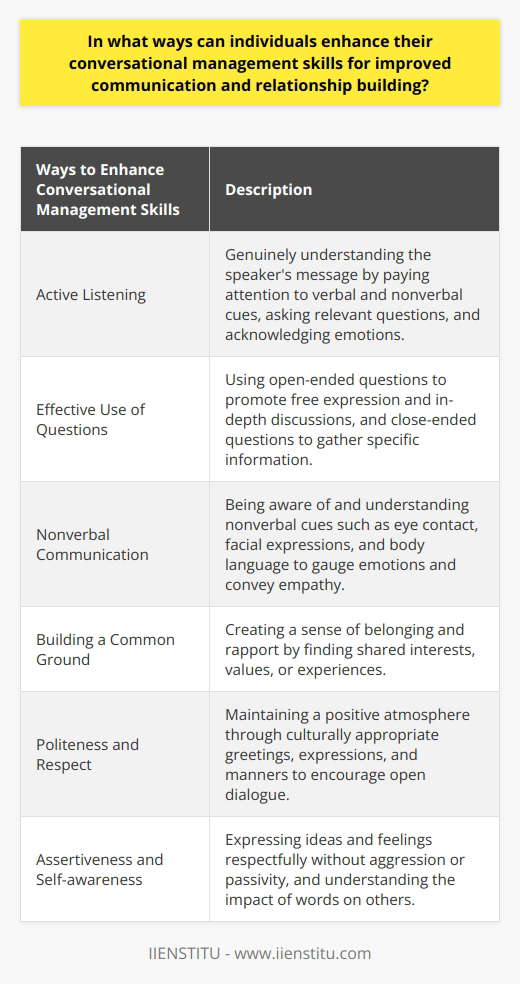
What are the fundamental principles guiding conversational management in interpersonal communication?
Fundamental Principles of Conversational Management
Effective interpersonal communication is crucial to forming strong social bonds and facilitating the sharing of ideas. Conversational management, which focuses on the organization and structure of verbal exchanges, is guided by certain principles which ensure the smooth flow of conversation.
Turn-taking System
The first principle is the turn-taking system, which dictates the alternating pattern of speakers during a conversation. Effective turn-taking involves knowing when to speak, realizing when someone else is about to talk, and respecting the other person's opportunity to express their thoughts. This principle is essential to avoid interruptions or monopolizing the conversation, ensuring a balanced exchange of ideas.
Eye Contact and Nonverbal Cues
Effective communication extends beyond just words; body language and eye contact play significant roles in conveying meaning and understanding. The second principle highlights nonverbal cues, such as facial expressions, gestures, and eye contact, in signifying agreement or disagreement, showing interest or disinterest, and conveying comprehension. These cues help manage conversation flow and signal mutual understanding or the need for clarification.
Active Listening
The third principle revolves around active listening, which involves not just hearing the words being said but also interpreting and understanding the intended message. Active listeners practice empathy, ask clarifying questions, and paraphrase the speaker's words to ensure accuracy. Providing feedback and validation is crucial in maintaining a healthy exchange.
Coherence and Relevance
The fourth principle, coherence and relevance, emphasizes maintaining consistency in the conversation's focus and ensuring that one's own contributions align with the topic. By staying relevant and coherent, participants maintain a clear and meaningful dialogue, leading to mutual understanding and a more fluid conversation.
Politeness and Civility
The final principle involves being polite and showing respect to the other individual or individuals involved in the conversation. This means paying attention to the choice of words, tone, and gestures, while avoiding offensive or inappropriate language. Practicing politeness and civility in communication ensures mutual respect and fosters an atmosphere that encourages open dialogue.
In conclusion, fundamental principles such as turn-taking, nonverbal cues, active listening, coherence and relevance, and politeness and civility greatly influence conversational management in interpersonal communication. These principles not only facilitate a smooth flow of conversation but also promote improved understanding and stronger relationships.
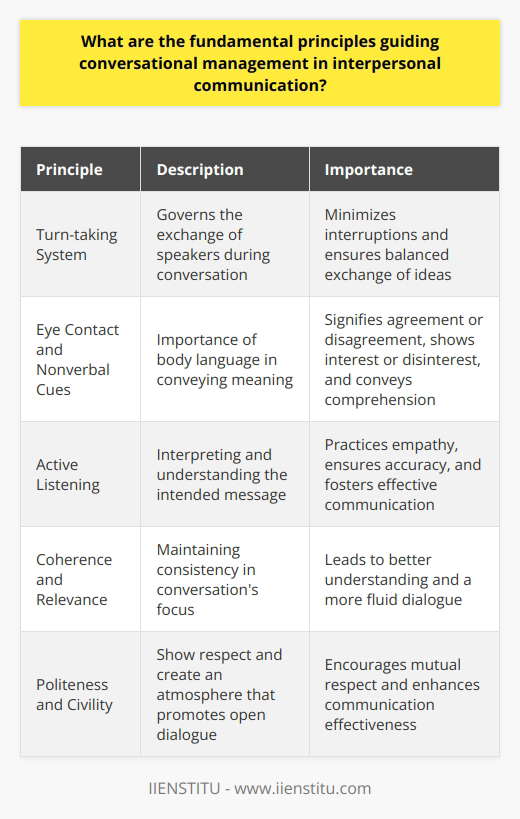
How can various communication styles impact the success of management conversations?
Communication Styles in Management Conversations
Understanding Communication Styles
Effective communication is the foundation for successful management. Recognizing and understanding various communication styles are essential in ensuring that managers are able to effectively engage and collaborate with their team members. This, in turn, fosters productivity and improves overall team performance. The four primary communication styles are assertive, aggressive, passive-aggressive, and passive.
Assertive Communication
Assertive communication involves confidently expressing one's thoughts, feelings, and needs in a respectful and honest manner. This communication style is considered the most effective in management conversations, as it promotes a sense of trust and openness between managers and their team members. By being clear and direct about expectations and goals, managers can minimize misunderstandings and ensure that everyone is on the same page.
Aggressive Communication
Aggressive communication, on the other hand, can be counterproductive in management conversations. This style often involves dominating conversations, interrupting others, and not showing empathy towards team members' feelings or opinions. By adopting an aggressive communication style, a manager may alienate their team, leading to decreased morale and productivity.
Passive-Aggressive Communication
Similarly, passive-aggressive communication can also be detrimental to the success of management conversations. This communication style involves indirect expressions of anger or dissatisfaction, often through sarcasm or subtle undermining of others. Passive-aggressive communication can create a hostile work environment, as team members may feel belittled, unappreciated, or confused about the manager's expectations.
Passive Communication
Lastly, passive communication often involves a lack of self-expression and responsiveness, which may lead to confusion and misunderstandings within the team. A manager who adopts a passive communication style may struggle to provide clear guidance or address team members' concerns effectively. Consequently, this can result in an overall lack of direction, which may hinder the team's progress and success.
Conclusion: Selecting the Appropriate Communication Style
In conclusion, the impact of various communication styles on management conversations can be profound. An assertive communication style is often the most beneficial for fostering productivity and open dialogue within a team. However, aggressive, passive-aggressive, and passive communication styles can negatively impact the success of management conversations by creating misunderstandings, fostering hostility or perpetuating confusion. By understanding and adopting the most effective communication style, managers can ensure that their conversations yield desired outcomes and contribute positively to their team's overall success.
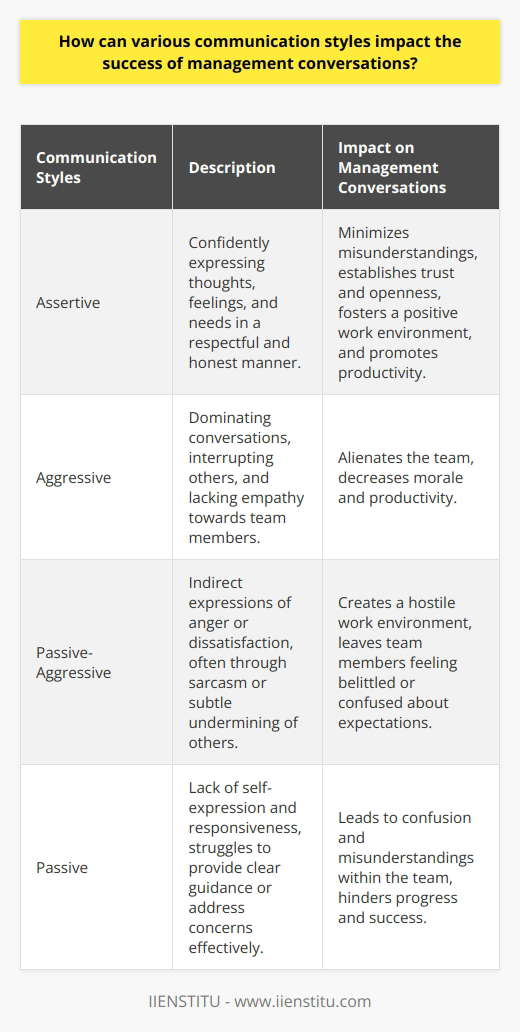
What strategies can be employed to overcome challenges in conversational management during interpersonal communication?
Effective Preparation
To overcome challenges in conversational management during interpersonal communication, one effective strategy is to be fully prepared for the conversation. This means having a clear understanding of the topic, staying informed about relevant issues, and being able to address misconceptions, disputes, or opposing views.
Active Listening
Another essential strategy is active listening, which involves showing genuine interest in the conversation, not only hearing but also interpreting and evaluating the messages being transmitted. This requires focusing on the speaker's verbal and non-verbal cues, asking clarifying questions to better understand their perspective, and empathizing with their emotional state.
Adapting Communication Style
Adapting one's communication style to suit various contexts, cultural backgrounds, and personalities is also crucial for smooth conversational management. This may require adjusting tone, language choice, and body language to ensure that the message is not lost in translation or misinterpreted. Additionally, being aware of one's communication preferences ensures that personal biases and assumptions do not hinder the conversation's progress.
Embracing Flexibility
In the face of conversational challenges, flexibility and openness to adapt are invaluable. This means accepting feedback, learning from mistakes, and being willing to shift strategies or perspectives when necessary. By embracing flexibility, individuals are better equipped to manage unpredictable and diverse conversational contexts.
Conflict Resolution Techniques
Lastly, employing conflict resolution techniques can go a long way in mitigating potential disruptions to effective conversational management. Such methods may include active listening, finding common ground, empathizing, and using solution-oriented language. By adopting these conflict resolution techniques, individuals are better prepared to handle disagreements and maintain a respectful dialogue.
In conclusion, overcoming challenges in conversational management during interpersonal communication can be achieved through a combination of effective preparation, active listening, adapting communication styles, embracing flexibility, and implementing conflict resolution techniques. By utilizing these strategies, individuals can better navigate complex conversational landscapes and foster more productive and meaningful interactions.
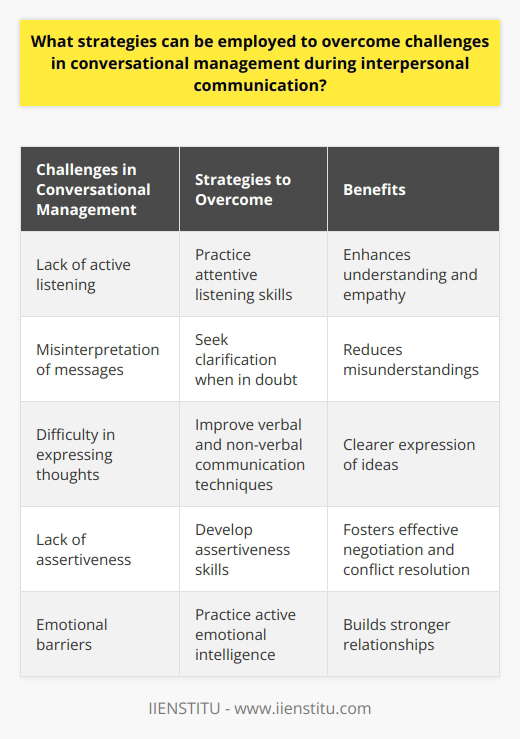
What is a systemic approach in counselling?
Defining Systemic Approach in Counselling
A systemic approach in counselling refers to a perspective that considers the influence of multiple contexts on an individual's experiences and behaviours. This includes assessing and understanding the interactions between the person and their environment, including family, societal, and cultural factors.
Understanding the Foundation of Systemic Counselling
The foundation of systemic counselling is based on theories such as family systems therapy, social constructionism, and the biopsychosocial model. These theories emphasize the interconnectedness and interdependence of individuals within a relational context, which necessitates a comprehensive and holistic approach when working with clients.
Applying Systemic Techniques in Counselling Practice
Counsellors who adopt a systemic approach use various techniques that focus on understanding the individual within their social and relational environment. Techniques may include genograms, circular questioning, and systemic hypothesis formulation, all of which help explore the client's experiences within their broader context.
The Role of Systemic Counselors
Systemic counselors take on the role of collaboratively working with clients to explore and identify patterns of interaction, communication, and behaviour within the individual's relational context. Through this process, counselors help clients gain insight into how these patterns may be contributing to their presenting issues and support them in developing new ways of relating to others.
Benefits of Systemic Approach in Counselling
The systemic approach offers several benefits in counselling. By promoting awareness of contextual factors, clients gain a deeper understanding of their issues, fostering stronger therapeutic alliances and facilitating more effective therapeutic outcomes. Additionally, the approach can be applied to a wide range of issues and client populations, showcasing its adaptability and versatility in counselling practice.
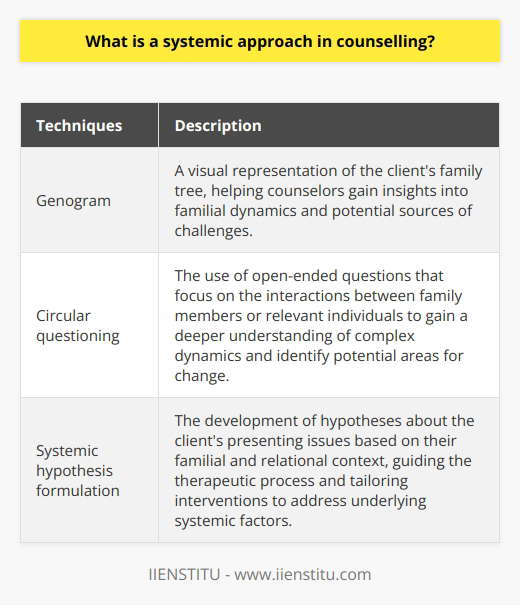
What are the systemic techniques utilized in therapy and how do they differ from other therapeutic approaches?
Systemic Techniques in Therapy
Systemic therapy focuses on understanding the individual within the context of their family and social environment. Unlike other therapeutic approaches, such as cognitive-behavioral therapy or psychodynamic therapy, systemic therapy is not centered on the individual's internal thought processes or past experiences. Instead, it examines the impact of relationships and communication patterns within the family and social system.
Family as a System
In systemic therapy, the family is seen as a complex and interconnected system, where each member's behavior influences others. The therapist's goal is to identify and understand the patterns of interaction and communication within this system, rather than solely addressing individual issues or diagnoses.
Strategic and Structural Interventions
Systemic therapists employ strategic and structural interventions to promote changes within the family system. Strategic interventions involve the therapist designing specific tasks or directives to disrupt dysfunctional patterns and encourage new ways of interacting. On the other hand, structural interventions focus on modifying the organization and hierarchy within the family to create a more balanced and functional system.
Cultural and Social Context
Systemic therapists also pay attention to the cultural and social context that may influence the behavior of individuals and families. They aim to assess the impact of these external factors on family dynamics, as well as acknowledge the resources and strengths that families can draw upon to foster change and growth.
Narrative Approach
Another technique utilized in systemic therapy is the narrative approach. This methodology encourages individuals and families to tell their stories, examine dominant narratives, and ultimately develop alternative narratives that support healthier patterns of interaction and communication.
Collaborative Relationship
Systemic therapists work in a collaborative manner, empowering individuals and families to take an active role in the change process. They promote open dialogue, encouraging clients to express their ideas, concerns, and goals throughout the therapeutic process.
In conclusion, systemic therapy differs from other therapeutic approaches by emphasizing the role of family and social systems in the individual's well-being. Techniques such as strategic and structural interventions, attention to cultural and social context, narrative approach, and fostering a collaborative relationship aim to promote changes not only within the individual but also within the broader system they belong to.
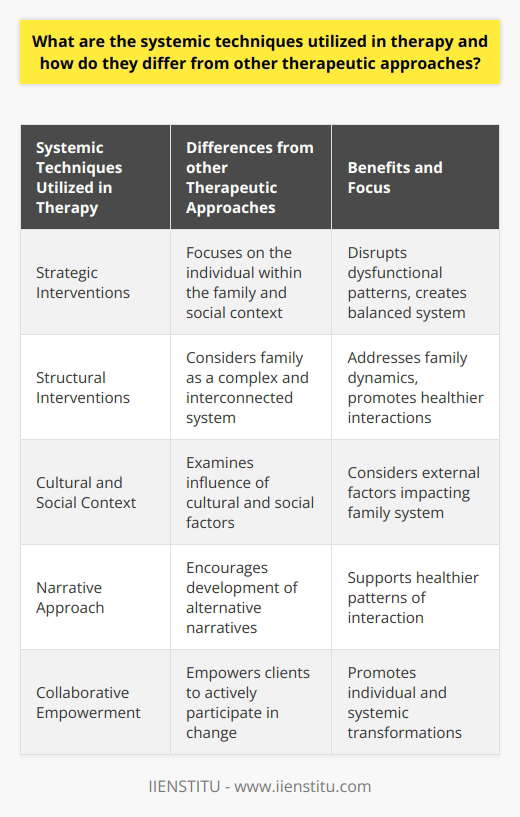
How does systemic thinking in marriage and family therapy contribute to addressing complex issues within families and relationships?
Systemic Thinking in Therapy
Systemic thinking in marriage and family therapy provides a valuable lens through which complex issues within families and relationships can be addressed. It allows practitioners to explore and understand the interconnectedness of family members and their influence on each other's well-being.
Understanding Family Systems
At the core of systemic thinking is the concept of the family as a dynamic system, wherein each member plays a role and affects other members. This conceptualization helps therapists identify patterns of interaction and underlying issues that may be contributing to conflict or stress within the family unit. By examining the complex network of relationships, therapists can better appreciate the factors influencing a family's functioning and can devise appropriate interventions.
Facilitating Positive Change
Systemic thinking recognizes that change in one family member may create a ripple effect throughout the entire system. By encouraging communication and fostering healthier connections between members, therapists can create opportunities for meaningful shifts in the family's dynamics. It is these changes that can contribute to the resolution of deeper issues, such as emotional distress, substance abuse or other psychological problems.
Empowering Families to Heal
Using a systemic approach empowers families to recognize and appreciate the strengths and resources that exist within their unique system. This awareness facilitates resilience and encourages family members to work collaboratively through challenging times. By fostering an environment of understanding and mutual respect, systemic thinking in marriage and family therapy can promote healing and growth within families and relationships.
In summary, the application of systemic thinking in marriage and family therapy provides an invaluable framework for addressing complex issues within families and relationships. It allows therapists to better understand the web of connections between family members, and it promotes change and healing by empowering families to work together, draw upon their strengths, and develop healthier patterns of interaction. Ultimately, this approach can contribute to more positive outcomes for individuals, couples, and families navigating the challenges of modern relationships.

